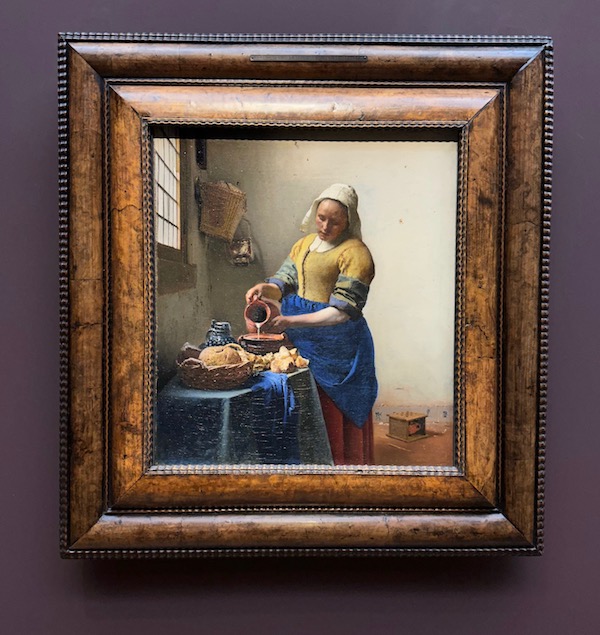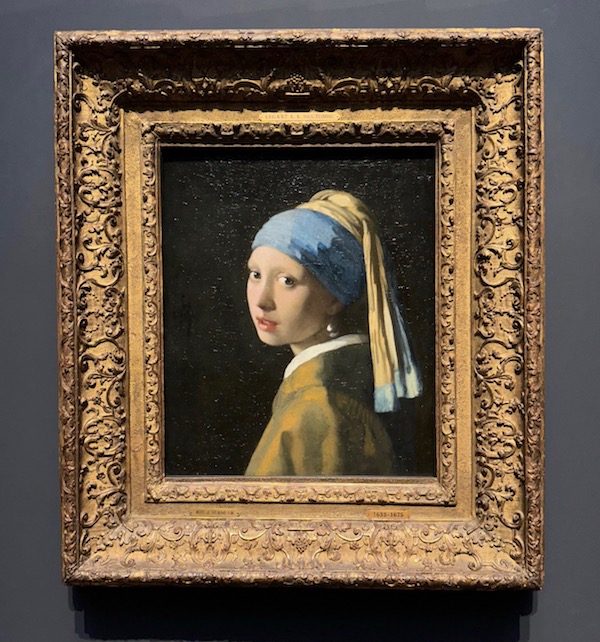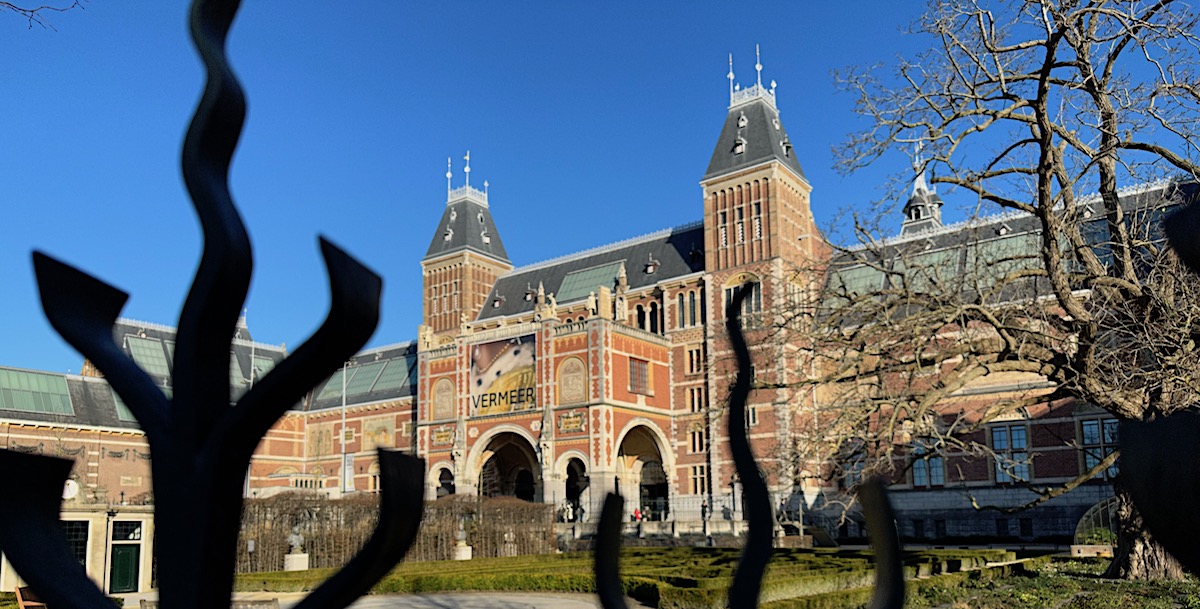Delft was Vermeer’s city. Stand in front of his small painting, The Little Street of 1658 and you will see cobbles and a gabled brick house with leaded windows, just as you still see all around you in the city today.
Unlike his contemporaries Vermeer was not interested in movement but in stillness – SH
A woman is sitting in a darkened doorway, sewing. Another stands in an alleyway, bent over a broom. In the foreground, a girl appears to be playing a game with a young boy on the pavement. Ordinary people going about their lives in the stillness of a Delft morning. There is a sense of order, of quiet domesticity in the red-bricked architecture and ordered rows of cobbles. Cleanliness appears, here, to be very close to Protestant godliness. The palette is constrained, our eye drawn to the central dark doorway by the white blob of the seated woman’s crisp bonnet and shawl. This is a whole world. Not the world found in Blake’s grain of sand, but in a morning of Dutch domesticity.

Not much is known about Vermeer’s life other than he lived most of it in Delft and that his father was some sort of art dealer. After his death, Vermeer married Catherina Bolnes, a young woman from a well-to-do, cultured Catholic family with whom he had fourteen or fifteen children, not all of whom survived. His output was comparatively small – he died in his early 40s – but he is one of those artists whose paintings, such as The Girl with a Pearl Earring, Women in Blue Reading a Letter or the Lacemaker, are almost more well-known than the artist himself. This wonderful exhibition, the first retrospective of Johannes Vermeer in the history of the Rijksmuseum, is not big. There are 28 paintings, (out of 36 in total) all beautifully hung in the darkly dramatic galleries.
Unlike his contemporaries Vermeer was not interested in movement but in stillness. Intense moments of revelation and quiet. A young woman in a dark room, lit only by the outside light spilling in from the window, fixes a row of pearls around her neck whilst she stares out into the larger world beyond. Inside and outside is a recurring theme. In the history of art, windows have a special significance as the painting itself is often seen as a ‘window’. In Young Woman with a Lute, a girl sits at a table tuning her instrument. Scattered in front of her are sheets of music. Others lie on the tiled floor next to a viola da gamba. Behind her is a large map of Europe showing the Netherlands’ place as a modern country interested in expansion and cartography. The young woman is dressed in a yellow silk jacket trimmed with ermine and is wearing a large pearl earring. (Though the fur may only be rabbit and the pearl, glass). The foreground of the painting is darkened, so in contrast, the girl’s face is highlighted. Her wide-eyed expression indicates that she is distracted by something going on outside that is much more interesting than tuning her lute. Elsewhere women write letters, sometimes watched over by a maidservant who, presumably, has greater access to the outside world and will be the person who will deliver the letter.

In another of Vermeer’s most celebrated paintings, The Milkmaid (or Kitchen maid), the slow stream of white milk being poured from her earthenware jug into a bowl, along with the highlights of her white bonnet and the reflected light on her bare, working girl’s forearm –again from a high window– give the painting its quiet spirituality. This is a libation. Her blue skirt and the blue tablecloth suggest the heavenly blue of more obviously religious paintings. You might almost be looking at an altarpiece by Pierro della Francesca.
There is the belief that Vermeer documented the domestic world of his time, but his is an invented pictorial world, an illusion of reality. Middle-class Dutch homes would not have had black and white tiled floors as in Woman Writing a Letter, with her Maid. His genius lies not only in the sensitivity of his compositions but in his ability to master perspective and to create optical effects with the sharpness and blurring of paint to reproduce different plays of light. Objects are created through colour and tonal values rather than graphically. Vermeer was the master of light. Yet however close you get to a painting, it’s hard to see the brush marks to discern how he did it. Lawrence Gowing described him as ‘all eye and nothing else….a walking retina drilled like a machine’.

Compared to our modern world, Vermeer’s would have been very quiet apart from the bark of dogs, the cry of playing children or a baby, the shouts of those selling goods in the market. You only have to look at Vermeer’s glorious View of Delft, painted between 1660-61, to see how empty and probably quiet the city was. A clutch of people stand by a boat; two women chat on the edge of the canal. The only sounds would have been their voices in the wind, the lapping water and the creaking of the wooden boats, broken hourly by a peel of church bells visible on the other side of the canal. But that comparative quiet would have been broken from time to time by music. Not only does Vermeer give us the girl with a lute, but we see the same girl playing a guitar. Elsewhere a woman stands at a virginal, while two other paintings show the young women seated at theirs. They look straight out at the viewer as if appealing directly to us and the world outside. These have been brought together for the first time in many a long year. One of these works comes from the National Gallery, London, the other from the Leiden Collection, New York.
So what is the huge appeal to us now of Vermeer? Why is he so popular? Perhaps it is because his work seems so modern. His subjects are not saints or heroes but family and close neighbours. His spare, minimal interiors are peopled by those with whom we can identify, ordinary people going about their daily lives, cooking, sewing, writing letters (love letters perhaps?), playing music, chatting, and being bored. Those in whom we can readily see something of ourselves and our own lives. And then, of course, there is the paint—Luminous, shimmering, almost otherworldly, applied by the hand of a master.
Words: Sue Hubbard Photos: P C Robinson © Artlyst 2023
Vermeer:Rijksmuseum Amsterdam 10 February – 4 June 2023 Daily 9 to 18h
Sue Hubbard’s recent novel Rainsongs is published by Duckworth, Overlook Press US, Mercure de France and Yilin Press, China.
Swimming to Albania, her fourth poetry collection is available from: www.salmonpoetry.com
Her novel Flatlands is due in June from Pushkin Press.
Radium Dreams, an exhibition of her poems and images by Eileen Cooper RA, on the life of Marie Curie for International Women’s Day, opens at the Women’s Art Collection, Murray Edwards College Cambridge on March 2nd
Vermeer’s Kitchen Maid by Sue Hubbard
An Easter light, watery as whey, spills
from the high window, catches the rim
of her linen cap, its white gulls’ wings,
the coarse cross-stitch of yellow bodice
against her apron’s blue, the sleeves
rolled to elbows against curdy skin.
Already she has raked ashes, broken bread
for him from the willow basket with her big
raw hands. And in the oyster-grey morning
while the house sleeps, Vermeer’s woman
pours warm milk from terracotta
jug to crock in silent communion.
She is mistress here,
moving with slow deliberation through
these daily tasks: her quiet meditations.
On the table beside her is spread
a Delft flagon of ale, a cloth; on the wall
a wicker creel, new polished brass.
Did he love her? Who can say?
As in the chill dawn he lifts his brush
to catch that creamy curve of brow
the shadow on her lowered lid where
sable tufts stroke, soft as her cool
fingers on fresh laundered ecru.
From Everything Begins with the Skin
Published by Enitharmon 1995

